3 Chipping Tips Any Golfer Can Use
3 Chipping Tips Any Golfer Can Use
09/26/2017
It’s easy to overlook chipping when you’re working to improve your golf game. Unlike driving and putting, you’ll only have to chip a handful of times each round. Even so, a solid chipping technique can mean the difference between a bogey and a birdie. And as most golfers are painfully aware, those bogeys can add up fast.
Fortunately, a few small adjustments in your method can help you chip the ball up and down right where you want it, setting you up for an easy putt almost every time. You just have to know the right way to approach the three elements of the ideal chip shot. Those elements include:
- Club selection
- Setup
- Motion
I will break these ideas down to help you build a solid foundation for your chipping technique. I’ll also share the one mistake most amateur golfers make and how to fix it.
First, let’s talk club selection.
Club Selection
Some golfers prefer to use a variety of clubs for chipping. However, if you don’t have a lot of time to practice, I suggest sticking to one or two clubs. That way you can really get the feel of a solid chip shot on those clubs, and you will get a sense of how each club can help you, depending on the type of chip shot you need to make.
I recommend using a pitching wedge or a lob wedge, depending on how you want the ball to land.
- Use the pitching wedge when you need to the ball to roll when it hits the green.
- Use a lob wedge for higher, softer shots. You can also use a sand wedge if your sand wedge is more lofted than your lob wedge.
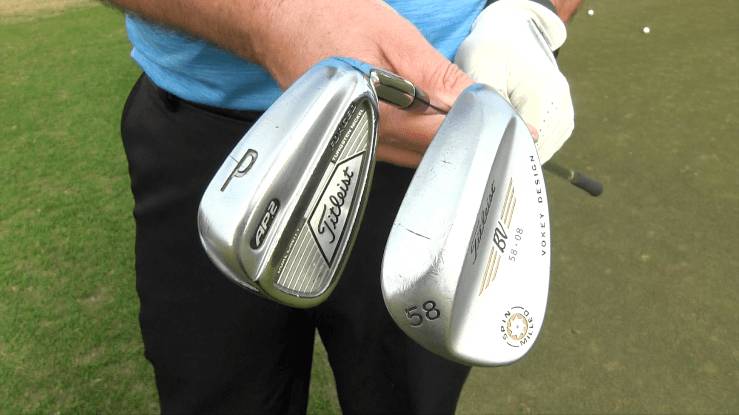
If you focus on chipping with these two clubs, you will learn the feel of the clubs and get a strong sense of when and how they can work for you.
Setup
As you know, a solid chip shot looks very different from a typical golf shot. In chipping, you want the ball path to be high and short. What some golfers don’t realize, however, is that even though the ball flight is very different, the motion should not be.
In fact, the motion of the chip swing is like a mini version of the regular golf swing. So, naturally, the setup is similar as well.
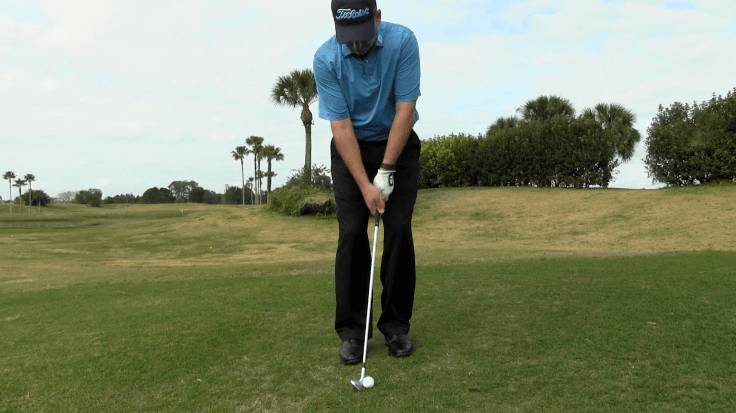
When preparing to chip your ball, be sure to keep your feet close together with more pressure focused on the lead foot. You want about 70% pressure on the lead foot and 30% on the trail foot.
Place the ball in the center of your stance. If you have a bad lie – for example, if the ball is in deep grass or a hole – position yourself so the ball is a little farther back in your stance, towards the trail foot. Otherwise, keep the ball centered.
Last, be aware of how the handle of the club is positioned in relation to the clubhead. Many amateur golfers make the mistake of holding the handle out in front of the clubhead. This position angles the entire club forward, which tilts the clubface and eliminates the loft – the upward angle that is built into your clubface.
This is called “de-lofting,” and it’s a mistake because your clubhead is designed with that loft to help you achieve the proper launch angle. The loft helps you get your ball up and down onto the green.
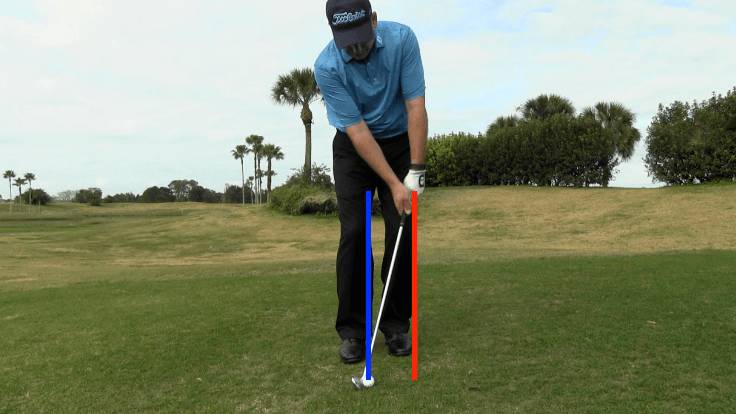
So, when you set up your chip shot, be sure to position your hands only slightly in front of the ball, making sure that you are not negating the loft of your clubhead.
Here’s a checklist for quick reference when you’re out on the course. When you’re setting up your chip shot, check for the following details:
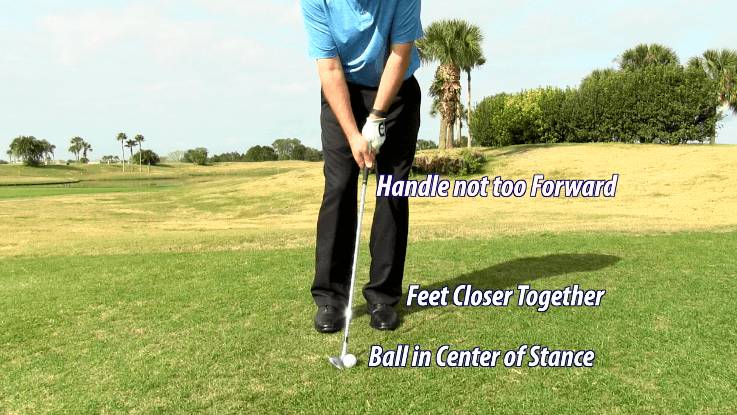
- Feet are close together.
- 70% pressure on the lead foot, 30% on the trail foot.
- Ball is in the center of stance (or a little back in stance if it’s a bad lie).
- Hands are just slightly in front of the ball.
Now that you’ve selected the right club and have mastered the setup, it’s time to think about the motion of your swing.
Motion
The success of your chip shot depends on your motion through three phases of your swing: the backswing, swinging through, and the finish.
The Backswing
When it comes to the backswing, a lot of golfers make the mistake of dragging the clubhead towards the inside of their hands, meaning the clubhead travels in closer to the body. When your backswing drags in like this, you catch the ball at the wrong angle.
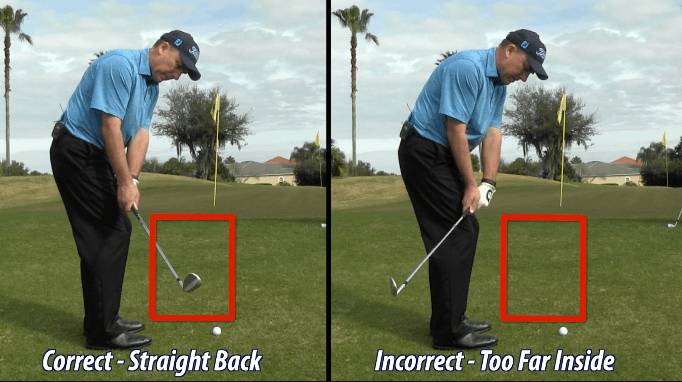
Instead, you want the clubhead to stay outside your hands as you swing back. It may help to think of the phrase “in the catcher’s mitt.”
Imagine you’re standing in the batter’s box. On your backswing, visualize the clubhead moving into the catcher’s mitt. This will set you up for a good angle of attack so you can make clean contact and chip the ball up onto the green right where you want it.
Swinging Through
Another phrase that will help you visualize ideal swing motion is “high to low.” In other words, your backswing should be higher than your forward stroke. This ensures a descending blow on the golf ball.
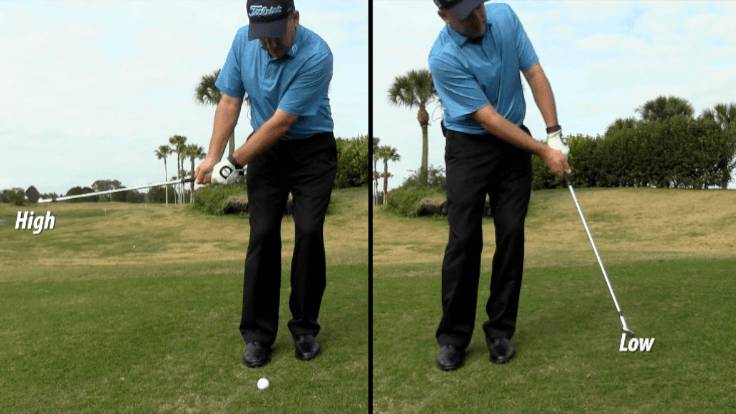
Many golfers struggle with the instinct to do the opposite. Because they’re thinking about chipping the ball up and down, they want to hit the ball at a low angle and lift it with a high forward stroke.
This impulse is both understandable and common, but it doesn’t do much to help you get that ball up onto the green. Fortunately, the more you practice proper swing technique, the better you train your body to forget the old “low to high” instinct and pick up the habit that actually works.
In the meantime, just keep reminding yourself: “high to low.”
Finish
When you finish your swing, the handle of your club should be pointing at your belt buckle. This ending position suggests that you haven’t hinged at the wrists or made any other motion that would incorrectly angle the club.
If you swing with the intention of finishing with the handle pointed at the belt buckle, you are much likelier to maintain the loft you need to chip your golf ball up onto the green.
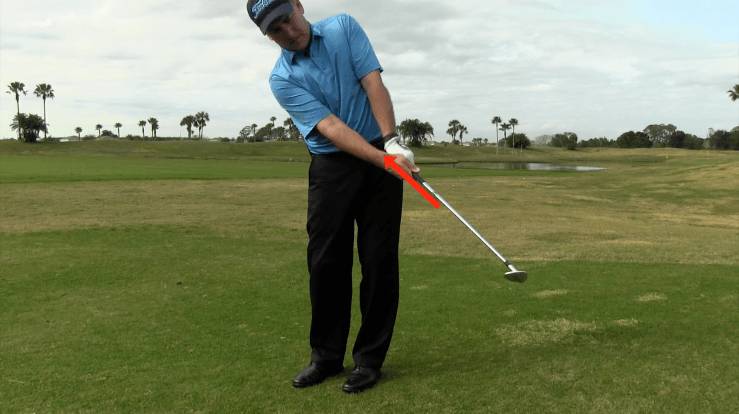
The Most Common Mistake
Now you know how to choose the best club for chipping, how to set up your swing, and what an ideal chip stroke looks and feels like. Before you get too comfortable, however, check your technique one more time to make sure you’re not making the most common chipping mistakes.
The most common chipping mistake is hinging at the wrists.
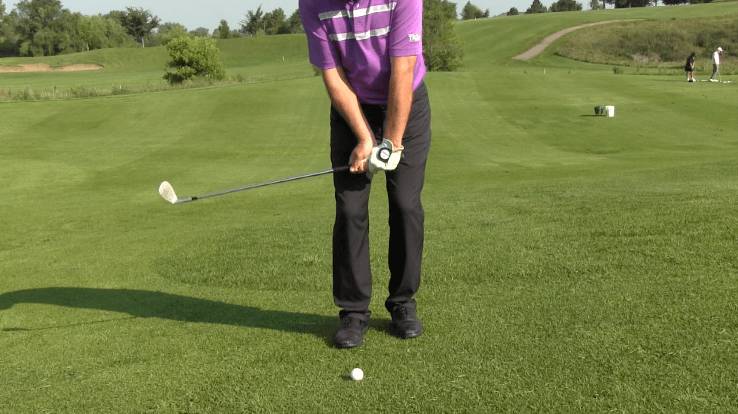
Not only do many amateur golfers hinge at the wrists on their backswing; many golfers have been advised to do this. The problem with hinging at the wrists is that it changes the angle of the clubhead, eliminating the loft and bounce that are so essential for making a stellar chip shot.
Instead of bending your wrists, think in terms of pushing the handle of your club away. This will help you control that backswing so that when you swing through, your clubface is neutral, providing the ideal launch angle (by making the most of the loft built into your club) and bouncing through the turf for clean contact (by making the most of the bounce).
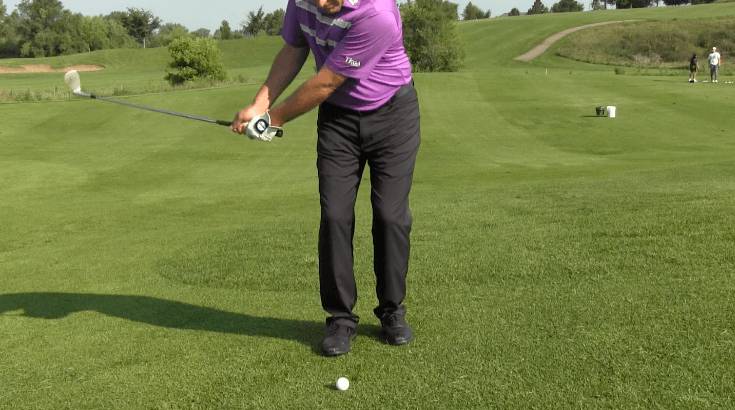
Summary Checklist
To review, when you practice your chipping, check to make sure you have the following elements in place:
-
Club Selection
- If you want the ball to roll, use a pitching wedge.
- If you want a high, soft shot, use a lob wedge or sand wedge, whichever one is more lofted.
-
Setup
- Feet are close together.
- 70/30 pressure in the feet.
- Ball is in the center of stance (or slightly back if it’s a bad lie).
- Hands are just slightly in front of the ball.
-
Motion
- Backswing: Move the clubhead “into the catcher’s mitt.”
- Swinging motion: Swing high to low.
- Finish: Club handle should be pointing at belt buckle at finish.
- Avoid the Most Common Mistake: Push the handle of your club away, rather than hinging at the wrists.
If your head is reeling with all this new information, don’t worry. The more you practice, the sooner this knowledge turns into habit…and the sooner you start to see real results on your scorecard.
What Do You Think?
Have you tried applying these elements to your golf game? Has it helped? Do you have any questions about chipping or want to share a method that has worked for you?
Let us know in the comments! We love talking golf and we’re all about helping you get those scores down. Join in the discussion and tell us what’s on your mind so we can continue to create content that will help you play better golf.


Thanks for the good tips.
Do you prescribe to the idea of arching the left wrist so as to reduce the wrist action on a chip shot?
Also, would you say it is preferred to try to keep the hands in front of the sternum as much as possible throughout the stroke to help keep the body/hands/arms in sync?
Lastly, sometimes I will tend to stub a chip shot to some extent, which results in the ball ending up weill short of the hoe. What would you say most likely causes this issue?